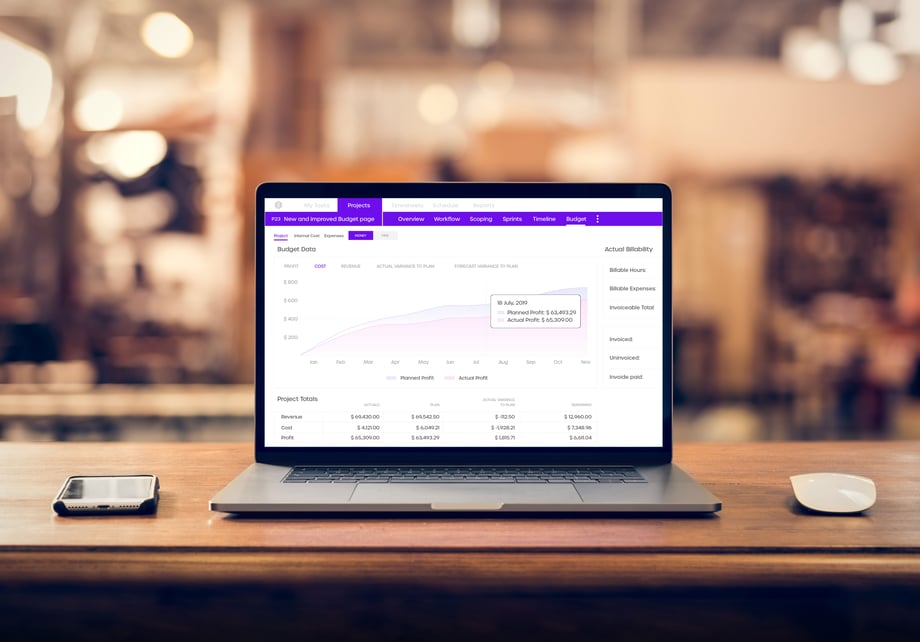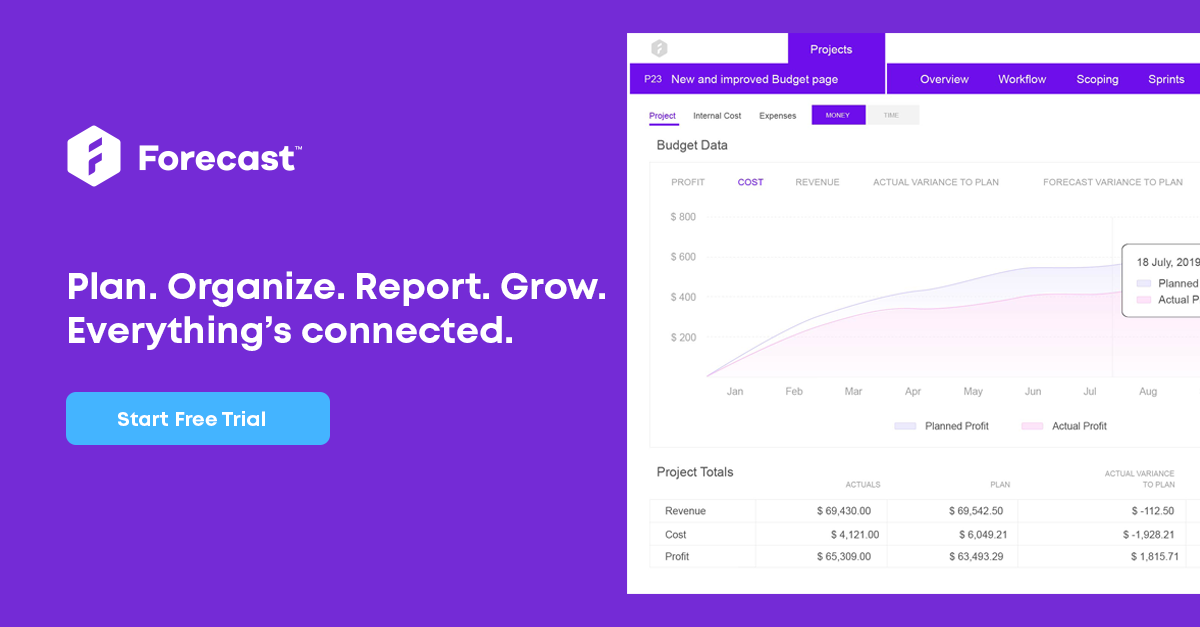How to Keep Projects on Budget Using Forecast

Even well thought out projects have cost and budget overruns if you lose sight of them at some point. Take, for instance, one McKinsey study that found that 66% of enterprise software projects go over budget. The lack of project management initiative and overview at the right time might cost companies lots of money.
To help project- and service-based companies deliver the expected value on time and within budget, we’ve developed the new superior budget feature, available as part of our premium plan, that helps CFOs collaborate with project managers to know the true cost of their projects in real time and spot cost overruns before they even appear.
What’s project budget management like in Forecast?
Forecast connects every part of the project data, such as estimates and time entries, and applies them to generate a project budget. The budget maps out the cost, revenue, and profit in real time and keeps you updated on critical spending metrics. The main advantage C-level executives get from the overview are insights into each project’s profitability, so you know which projects are making money and which are lagging behind.
Designed with flexibility in mind, Forecast offers visibility into the financial aspect of the project in one single view. What you’ll see is how the project is progressing based on two important cost measurement units – the planned and actual cost. This way you’ll be able to track the budget against the original plan and, more importantly, drill down and understand what’s costing more money than expected.
Additionally, the software lets you work with fixed-price projects or invoice your clients underway and makes it easy to follow the billability of the projects. If invoices were created in Forecast, the platform shows how much has been paid and invoiced. Syncing with your favorite accounting tools, like Quickbooks, Xero, or e-conomic, is also an option as Forecast integrates with them all.
Creating a project budget in Forecast
In Forecast, calculating a project budget goes hand in hand with having your team members working on the tasks. In order to determine the actual revenue, cost, and profit, it’s essential to know how much you bill for their time and what you pay them.
When adding a fixed price, the planned revenue will show up, based on the roles and team members you've assigned. This number can be used to get an understanding of how much the company should earn by doing this particular project.
Additionally, Forecast provides a field to enter markup percent to your budget. Use it for giving discounts or adding a buffer so you know no money will be lost on delivering the project. Forecast’s AI helps you estimate the length of the task and suggests people who are able to complete them, so if some tasks were forgotten, the system will remind you to add them to the scope.
The case for keeping your project budget under control
Imagine it’s the end of the month, and the management team is having their status meeting discussing how the projects are, what is going on, and what to be aware of. The focus narrows down to profitability and where the company is earning money.
At the meeting, senior managers look at the budget list and project list in the reports section. They first talk about the project status. It is added by the project manager responsible for the project who reports to the lead project manager who is now in charge of communicating about the project health.
Management is most curious to see if things are on track – looking into the following three metrics:
- Revenue: the income the business will get from each project.
- Cost: the total funds needed to complete and deliver the project, including the salaries.
- Profit: the difference between the amount earned and the amount spent.
Tied with the discussion about different projects and their progress, the talk turns to the budget list. Here they would like to know how the numbers correspond. If something doesn’t look good, they would drill down to inspect the numbers.
At the budget page, they can look at the overall graph, especially at the actual variance, compared to planned. It illustrates how the time entries correspond to the plan and how it all affects the revenue.
So let's say we have planned the project and estimated it will take approximately 100 hours. When we actually start working on the project, and people begin to make time entries, in the middle of the project we realize that we have already made entries that are 70 hours in total.
This will make the planned vs. actuals on the graph look not so good as expected. Most likely, in this case, we’d want to find out why people have registered more time. The platform allows you to go down to the smallest work detail, catch sight of the milestones that went crazy, and thus figure out what role registered more time and needs help. If they want to hold the numbers up against each other, they’d look at the total price of work and expenses.
In short, effective project cost management never goes without two things: accurate estimation and budget tracking. Both can be done with the help of project management systems that keep all the data connected in one place to benefit from seeing every single aspect of work involved as it contributes to the bigger picture.
At Forecast, we’ve made sure you can answer three key questions related to the project finances.
- Where do I earn the revenue?
- What is costing me more money than I expected?
- How do I ensure more profitable projects?
Want to know more? Forecast is an AI-powered platform that helps project-based companies look into the future by connecting people and projects with insights and profitability. Sign up for a free 14-day trial to get a better understanding of how you can put all your data to use.
You might like to read these articles on our blog..
Subscribe to the Forecast Newsletter
Get a monthly roundup of productivity tips & hacks delivered straight to your inbox

